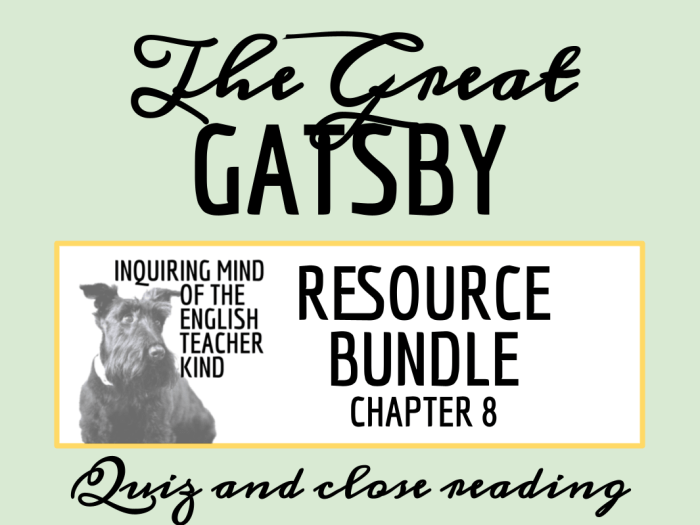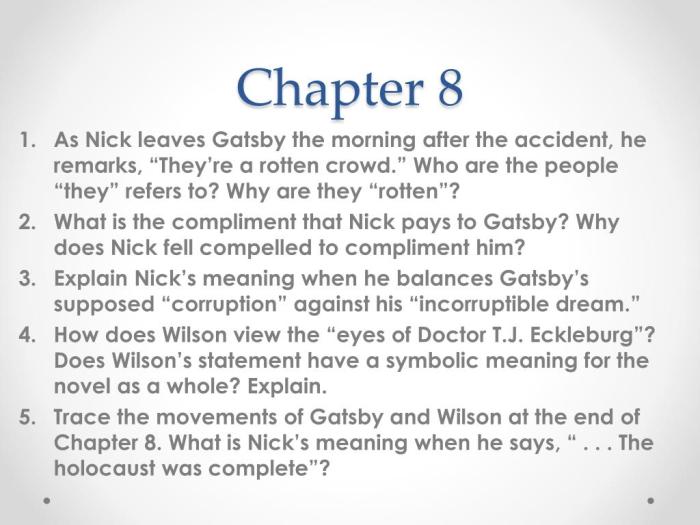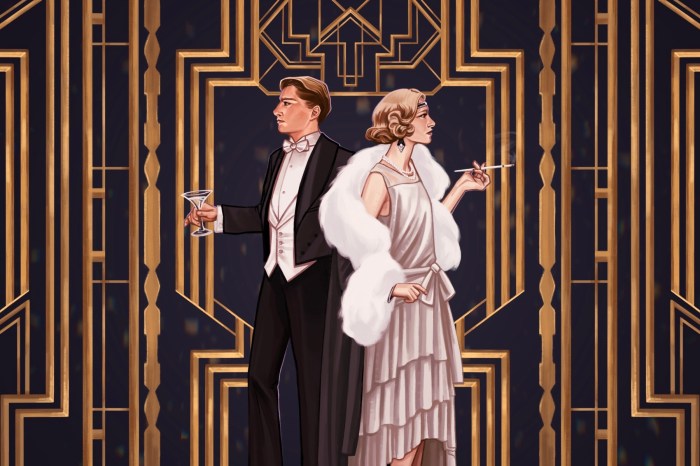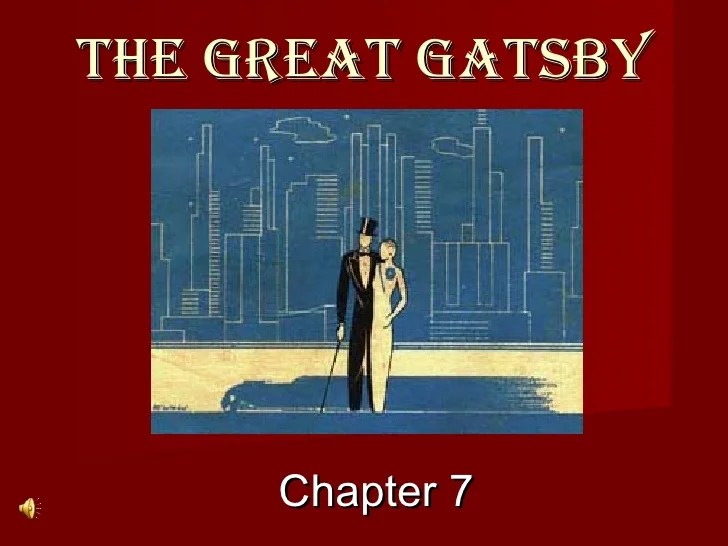Embark on an intriguing journey with our Great Gatsby Chapter 8 Quiz! Dive into the enigmatic world of F. Scott Fitzgerald’s masterpiece, uncovering hidden meanings and exploring the complex characters that inhabit Gatsby’s lavish parties.
From Gatsby’s elusive past to the unraveling relationships between Daisy, Tom, and Jordan, this quiz delves into the heart of Chapter 8, shedding light on the novel’s enduring themes and symbolism.
Chapter Summary

Chapter 8 of “The Great Gatsby” marks a turning point in the novel, as the characters’ relationships and motivations are laid bare. The chapter opens with a confrontation between Tom and Gatsby at the Plaza Hotel, where Tom reveals that he knows about Gatsby’s past and his love for Daisy.
This revelation leads to a series of events that culminate in the tragic death of Myrtle Wilson.The chapter also explores the themes of class and social status, as Gatsby’s true identity and humble beginnings are exposed. The contrast between Gatsby’s wealth and his lack of social acceptance highlights the superficiality and hypocrisy of the upper class.
Character Analysis: Great Gatsby Chapter 8 Quiz

In Chapter 8, the relationships and conflicts between the novel’s key characters become increasingly complex. Gatsby’s pursuit of Daisy intensifies, while Tom and Jordan’s marriage unravels.
Gatsby and Daisy
Gatsby’s love for Daisy remains unwavering, despite her marriage to Tom. His determination to win her back leads him to confront Tom, resulting in a tense encounter at the Plaza Hotel. Daisy’s emotions are torn between her love for Gatsby and her loyalty to Tom.
Tom and Daisy, Great gatsby chapter 8 quiz
Tom’s possessive nature and disregard for Daisy’s feelings drive a wedge between them. Daisy’s growing disillusionment with Tom’s arrogance and infidelity becomes evident in their heated argument.
Jordan and Tom
Jordan’s affair with Tom continues, but she is increasingly dissatisfied with his behavior. She realizes that Tom is incapable of true love and commitment, and her loyalty to Daisy wavers.
Nick and Jordan
Nick’s relationship with Jordan deepens as he witnesses the complexities of her involvement with Tom. He becomes aware of Jordan’s manipulative nature but also recognizes her vulnerability and desire for a meaningful connection.
Symbolism and Motifs

Chapter 8 of The Great Gatsby is rife with significant symbols and motifs that contribute to the novel’s overarching themes and meanings.
The Valley of Ashes
The Valley of Ashes is a desolate wasteland that symbolizes the moral decay and emptiness of the American Dream. Its inhabitants, like George Wilson and Myrtle Wilson, are trapped in a cycle of poverty and despair, representing the forgotten and marginalized members of society.
The Eyes of Dr. T. J. Eckleburg
The faded billboard advertisement of Dr. T. J. Eckleburg, an optometrist, looms over the Valley of Ashes. His all-seeing eyes serve as a constant reminder of the moral judgment and surveillance that permeates the novel’s world.
The Green Light
The green light at the end of Daisy’s dock symbolizes Gatsby’s unattainable dream of recapturing the past and winning her love. Its elusive nature reflects the futility of his quest and the impossibility of escaping the consequences of his actions.
The Yellow Car
The yellow car, driven by Gatsby and later Myrtle Wilson, becomes a symbol of recklessness, danger, and the consequences of illicit affairs. Its fatal crash foreshadows the tragic events that will unfold in the novel’s climax.
The Ashes
The ashes of the Valley of Ashes represent the remnants of failed dreams and lost hope. They are a reminder of the destructive power of materialism and the emptiness that can result from pursuing unattainable goals.
Literary Devices

Chapter 8 of The Great Gatsby employs a range of literary devices to enhance the reader’s comprehension and engagement with the story. These devices include foreshadowing, imagery, and irony, each contributing to the novel’s rich tapestry of meaning and emotion.
Foreshadowing
Foreshadowing is used throughout Chapter 8 to hint at future events and create a sense of suspense. For instance, the description of the “death car” parked outside Gatsby’s mansion suggests the impending tragedy that will unfold later in the novel.
Similarly, the mention of Daisy’s “white roadster” foreshadows the accident that will ultimately lead to Gatsby’s demise.
Imagery
Imagery is used extensively in Chapter 8 to create vivid sensory experiences for the reader. The description of the “hot, still summer night” and the “oppressive heat” conveys the suffocating atmosphere of the evening, while the “yellow cocktail music” and the “laughing voices” evoke the superficiality and emptiness of Gatsby’s party.
The Great Gatsby Chapter 8 quiz will test your understanding of the chapter’s events and themes. If you’re looking for additional practice, check out the Abeka English 12 Test 9 , which covers similar literary concepts. Afterward, return to the Great Gatsby Chapter 8 quiz to solidify your comprehension of the chapter’s intricacies.
Irony
Irony is used in Chapter 8 to create a sense of contrast and highlight the complexities of the characters and their situations. For example, the irony of Gatsby’s lavish party taking place on the same day as Myrtle Wilson’s funeral underscores the superficiality of the upper classes and their disregard for the lower classes.
Similarly, the irony of Gatsby’s dream of recapturing the past being shattered by the reality of the present highlights the futility of his pursuit.
Historical and Cultural Context
Chapter 8 of The Great Gatsbyis set during the Roaring Twenties, a period of economic prosperity and social change in the United States. The American Dream, the belief that anyone can achieve success through hard work and determination, was a driving force behind the era’s optimism and excess.
The Roaring Twenties
- A period of economic prosperity and social change in the United States.
- Characterized by a surge in consumer spending, technological advancements, and a loosening of social norms.
- The stock market boomed, and new industries emerged, creating a sense of wealth and opportunity.
The American Dream
- A belief that anyone can achieve success through hard work and determination.
- A central theme in American literature and culture.
- The pursuit of the American Dream often leads to disappointment and disillusionment, as seen in the characters of Gatsby and Daisy.
These historical and cultural factors influence the characters’ actions and the events of Chapter 8 in several ways. The Roaring Twenties’ atmosphere of optimism and excess contributes to Gatsby’s grandiose plans and his belief that he can win back Daisy.
The American Dream drives Gatsby’s pursuit of wealth and status, but it ultimately leads to his downfall.
Themes and Meanings
Chapter 8 delves into profound themes that resonate throughout “The Great Gatsby.” These themes explore the complexities of love, loss, and the pursuit of the American Dream.
The Illusion of Love
- Gatsby’s love for Daisy is an idealized fantasy, built on the past and a distorted memory of their brief romance.
- Daisy’s feelings for Gatsby are ambivalent and conflicted, revealing the superficiality of her affections.
- The relationship between Gatsby and Daisy is doomed from the start, as it is based on a false foundation.
The Fragility of the American Dream
- Gatsby’s pursuit of wealth and status is ultimately futile, as it cannot bring him true happiness or fulfillment.
- The American Dream is shown to be elusive and unattainable, especially for those from humble beginnings.
- The novel critiques the materialism and social inequality that permeate American society.
The Power of the Past
- The past haunts the characters, shaping their present actions and decisions.
- Gatsby is unable to escape his past as a poor boy from the Midwest, despite his newfound wealth.
- Daisy is trapped by her marriage to Tom and the expectations of society, preventing her from pursuing her true desires.
Commonly Asked Questions
What is the significance of the green light at the end of Daisy’s dock?
The green light symbolizes Gatsby’s hope and longing for Daisy, representing his dream of recapturing their past love.
How does the character of Myrtle Wilson contribute to the novel’s themes?
Myrtle represents the working class and the consequences of Tom’s infidelity, highlighting the social divide and moral decay of the Roaring Twenties.
What is the meaning behind the Valley of Ashes?
The Valley of Ashes represents the industrial wasteland and moral decay that exists alongside the wealth and glamour of Gatsby’s world.